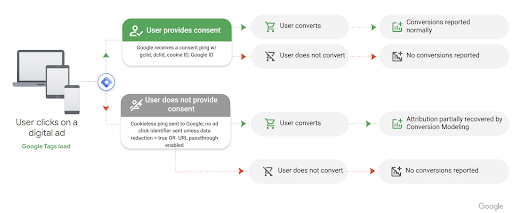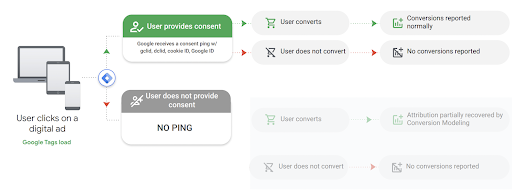SUMMARY
This article discusses the challenges that digital advertisers face with regard to tracking and attribution, particularly in light of the GDPR legislation. It also discusses Google's solution to these challenges, called Consent Mode, and the debate surrounding its use of cookieless pings for modelling. It will also compare the full and basic implementations of Consent Mode and their respective advantages and disadvantages.
Introduction
Tracking and attribution have always been hot topics in our digital marketing industry. Indeed, it is at the centre of what we do: measuring and evaluating the success of our digital communication.
These two concepts have become more and more challenging in the past years, and it won’t stop there.
Since the appearance of the GDPR legislation in Europe, advertisers have to clearly explain to their users what they will do with their data and if the users accept this usage.
Furthermore, if they don’t consent to this, advertisers can’t track the behaviour of these users.
Therefore, many tools, that are largely used in digital advertising, are heavily impacted: Web Analytics tools (Google Analytics, Adobe Analytics, etc), advertising platforms (Google Ads, Meta ads, etc).
Eventually, fewer data will be recorded by these platforms which will impact reporting and optimization. This is where it gets frustrating: the data we collect is not 100% accurate.
Google came with its own solution to model a part of the data that is missing due to users not consenting to the cookies: Consent Mode. You will find more information about this very interesting topic in this article.
The debate
Even if this feature seems very promising, there is still a lot of debate within the industry regarding the cookieless pings that are used for modelling.
- Is it allowed to send the data included in these cookieless pings to Google?
- If people refuse cookies, why would I still be sending data to Google?
But what is a cookieless ping? This is the information that is still sent to Google for every user refusing the cookies. It only contains functional and non-identifying information. According to Google, with this data, there is no way that Google can understand who the user is (= non-identifying). Thanks to these pings, and thanks to the data that was collected from the users accepting cookie, Google will be able to model the behaviour of these users. Therefore, these pings are crucial for the success of the modelling.
Even if Google claims that it’s GDPR-compliant, the American giant felt the pressure from many advertisers raising questions about this sensitive topic. That’s why they created an basic version of Consent Mode that won’t use any conversion pings for its modelling. Indeed, it will only use the data of the users that gave consent to model the conversions of those that didn’t. In other words, no data of the user itself will be used to model its behaviour.
The 2 different implementations
The illustrations below explain the differences between the full and basic implementations.
- In the full implementation, the modelling is based on conversion pings that are taken from the users that refused the cookies (better modelling)
- In the basic implementation, no data from those refusing users will be used. The modelling will only be based on an extrapolation of the behaviour of the ones that accepted the cookies (less modelled data)
Full implementation:

Basic implementation:

The advantages of the basic implementation are clear: no data about people refusing cookies is sent to Google, but we can still model some of the conversions that we lost.
This seems like the ideal solution, right? Why shouldn’t we use this instead of the standard version of Consent Mode?
This is because it has some disadvantages:
- Google takes a way larger safety net with the basic implementation. In other words, you will track less data which will bring you further away from the “reality”. This loss of data will impact optimization and reporting.
- Furthermore, the basic implementation only models conversions in Google Ads, nothing will be modelled in GA4 at the moment.
Nevertheless, this solution is still way better than just ignoring the behaviour and therefore, the conversions of people refusing the cookies.
Conclusion
Google developed a basic version of Consent Mode which allows you to avoid sending any information to the tech company. This solution is a great way to start modelling conversions and is a first step towards a complete modelled set-up. Furthermore, it won’t lead to any GDPR or legal debate as nothing about the users refusing cookies will be used.
Nevertheless, let’s not forget that this is not available for GA4 modelling and that you will model fewer conversions than with the full implementation.
Are you interested in this topic and want to know more? Don’t hesitate to contact Semetis to discuss it.
